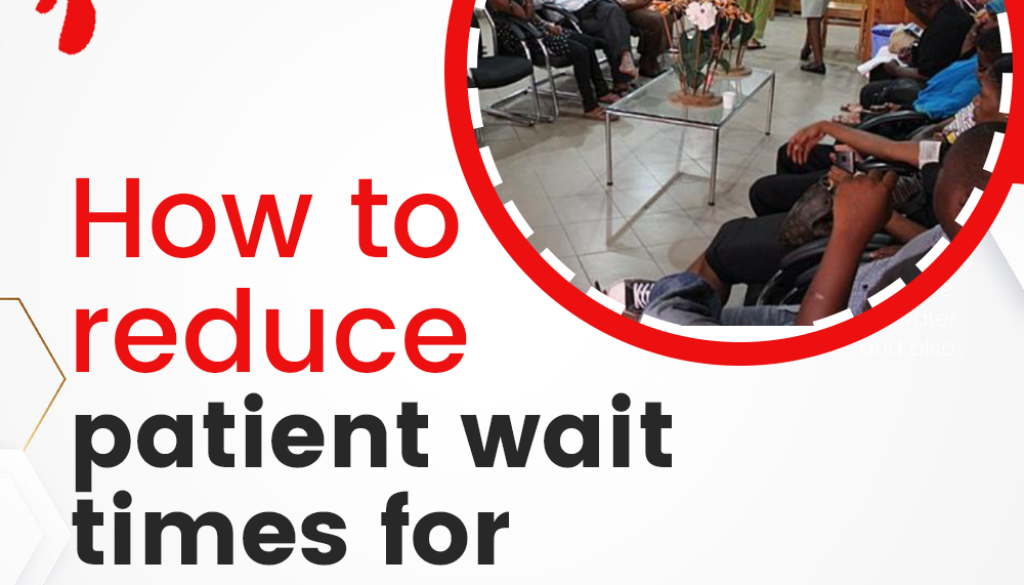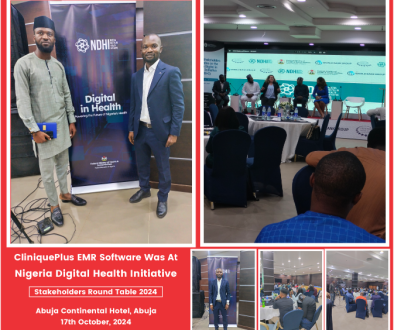How to reduce patient wait times for Nigerian Clinics
Patient wait times are a prevalent issue in Nigerian healthcare facilities, leading to frustration and dissatisfaction among patients and healthcare providers. There are several causes of long wait times, including inefficient appointment scheduling, understaffing, complex medical procedures, and emergency cases. To reduce patient wait times, healthcare businesses can implement innovative ideas that improve efficiency and patient flow management.
Use of EMR Software
One of the strategies that healthcare businesses can implement is the use of digital tools such as Electronic Medical record (EMR) software.
Best EMR software Nigeria
EMR software like CliniquePlus provides features such as appointment scheduling, patient management, and telemedicine that can contribute to reducing wait times. By automating administrative tasks and optimising patient flow management, healthcare businesses can significantly improve the efficiency of their operations, freeing up staff members to attend to patients, thereby reducing wait times.One of the innovative ideas that healthcare businesses can implement is the use of digital tools such as CliniquePlus EMR software. CliniquePlus EMR software is easy to use, and healthcare businesses can start with the free plan to test the software’s robustness and efficiency. Get started with FREE trial
https://docs.google.com/forms/d/e/1FAIpQLScMqYDxKwA3-yOE7Gqlq8XkP8DjNOgtBV7_LenKkiEEsbWsSQ/viewform
Moreover, EMR software includes a triage system that prioritises patients based on the severity of their condition. This feature can help healthcare businesses reduce wait times for urgent cases by ensuring that they receive prompt attention. In addition, the telemedicine feature allows healthcare providers to provide virtual consultations, reducing wait times for in-person appointments. Patients can receive care from the comfort of their homes, reducing the need for physical visits and wait times in clinics or hospitals.
Reorganising The Clinic or Hospital Layout
One effective way to reduce wait times is by reorganising the layout of healthcare facilities. Here are some ideas on how to achieve this:
Improve Traffic Flow: Ensure that there is a clear traffic flow within the facility that directs patients towards registration, waiting areas, consultation rooms, and examination rooms. By doing this, patients are able to move quickly and efficiently through the facility, minimising confusion and congestion.
Optimise Waiting Areas: Waiting areas can be a source of frustration for patients, especially when they are crowded or uncomfortable. By optimising the layout of waiting areas, healthcare businesses can increase the number of available seats and provide comfortable seating arrangements, reducing wait times and increasing patient satisfaction.
Reorganise Exam Rooms: Reorganise examination rooms to optimise their use and improve patient flow. Placing examination rooms in a central location, for instance, makes it easier for patients to access them. You can also use shared rooms, which can be used by multiple physicians to reduce wait times.
Incorporating these ideas into your healthcare facility’s layout can help to reduce patient wait times, improve patient satisfaction, and ultimately lead to better patient outcomes.
Staff Optimization
Optimise the layout to ensure that staff members are positioned where they are needed the most. Placing nurses and physicians in areas where they can quickly access patients and address their needs can improve staff efficiency, leading to reduced wait times and improved patient satisfaction.
Place Signage Appropriately
Simplify navigation by using clear signage and wayfinding to direct patients towards the areas they need to go. This can reduce confusion and congestion, making it easier for patients to move through the facility quickly and efficiently.
Appropriate signage in a healthcare facility can not only benefit patients but can also help staff to reduce wait times and improve their efficiency. Clear and concise signage can help staff navigate the facility more quickly and efficiently, allowing them to focus on their tasks and responsibilities.
For example, labelling storage areas with clear signs can help staff to locate supplies and equipment more easily, saving time and reducing the risk of errors. Signage can also be used to designate specific areas for different functions, such as exam rooms or consultation areas, which can help staff to prioritise their tasks and manage their time more effectively.
In addition, well-designed signage can also help to reduce the time patients spend waiting by directing them to the appropriate areas more quickly and efficiently. By reducing the time patients spend waiting, staff can see more patients in a shorter amount of time and provide care more efficiently.
Overall, appropriate signage can help to streamline operations, reduce wait times, and improve efficiency for both staff and patients. By making it easier for staff to navigate the facility and manage their time, healthcare facilities can provide better care to their patients and improve the overall patient experience.
Engaging Temporary Medics (Locum Staff)
Locum staff can be an effective solution for Nigerian clinics to reduce patient wait time and ensure that patients receive timely care. Here are a few ways in which locum staff can help to achieve this:
Increased staffing: Locum staff can help to alleviate staffing shortages in Nigerian clinics. By providing additional staff on a temporary basis, clinics can increase their capacity to see more patients, reduce wait times, and ensure that patients receive timely care.
Flexible scheduling: Locum staff can offer flexible scheduling options, allowing clinics to expand their operating hours or provide coverage during peak times. This can help to reduce wait times and ensure that patients have access to care when they need it.
Shorter appointment wait times: By increasing staffing levels, clinics can offer shorter appointment wait times, allowing patients to be seen more quickly and reducing the amount of time they spend waiting in the clinic.
Improved efficiency: Locum staff are often experienced professionals who can work efficiently and effectively, helping to improve the overall efficiency of the clinic. This can help to reduce wait times by streamlining processes and ensuring that patients are seen in a timely manner.
One way for Nigerian clinics to find the best locum staff is to discuss with their existing staff and ask for recommendations. Many healthcare professionals have a network of experienced colleagues who may be available for temporary work. By tapping into these networks, clinics can find high-quality locum staff who are familiar with the Nigerian healthcare system and can provide excellent patient care.
Another option is to reach out to staffing agencies that specialize in providing locum tenens services. These agencies have access to a large pool of healthcare professionals who are available for temporary work and can help clinics to find the right staff to meet their needs. However, it’s important for clinics to do their due diligence when selecting a staffing agency to ensure that they are reputable and provide high-quality candidates.
Overall, by leveraging their existing networks and partnering with reputable staffing agencies, Nigerian clinics can find the best locum staff to help reduce patient wait times and provide high-quality care.
In summary, hiring locum staff can be an effective way for Nigerian clinics to reduce patient wait times and ensure that patients receive timely care. By providing additional staffing, offering flexible scheduling, and improving clinic efficiency, locum staff can help to improve the overall patient experience.
Have SOPs
Standard Operating Procedures (SOPs) can play a crucial role in reducing patient wait times in Nigerian clinics and hospitals. SOPs provide a systematic approach to healthcare service delivery, ensuring that all aspects of patient care are streamlined and efficient. Here are some ways that having SOPs can help reduce patient wait times:
Consistency: SOPs ensure that staff members follow the same process for each patient visit. This consistency reduces the likelihood of errors or delays in the delivery of care, which can contribute to longer wait times.
Efficiency: SOPs can help staff members to work more efficiently by providing clear guidelines for each step of the patient visit. This can include processes for registration, triage, examination, treatment, and discharge. When staff members have a clear understanding of their roles and responsibilities, they are better equipped to manage their time and prioritize patient care, leading to shorter wait times.
Accountability: SOPs provide a clear framework for accountability in healthcare service delivery. When staff members understand the importance of their role in the patient visit process, they are more likely to take ownership of their responsibilities and work towards meeting the goals of reducing wait times.
Performance Measurement: SOPs can also help healthcare facilities to measure performance and identify areas for improvement. Regular monitoring and evaluation of the patient visit process can help to identify bottlenecks, inefficiencies, and areas where staff members may need additional training or support. By addressing these issues, healthcare facilities can work towards reducing wait times and improving patient outcomes.
Patient Satisfaction: Finally, SOPs can contribute to overall patient satisfaction by providing a consistent and efficient patient visit process. When patients experience shorter wait times, they are more likely to have a positive perception of the healthcare facility and are more likely to return for future care.
Training & Retraining
Developing a comprehensive training strategy and execution plan can help Nigerian clinics to ensure that their staff members are well-trained and equipped to provide high-quality patient care in an efficient and timely manner. Here are some steps that clinics can take to develop and implement a training strategy:
Identify areas for training: Start by identifying the areas in which staff members need training. This may include specific skills, procedures, or software applications. It is important to involve staff members in this process to ensure that training is targeted to their needs.
Develop a training plan: Once areas for training have been identified, develop a plan for how training will be delivered. This may include a combination of in-person training, online courses, and on-the-job training. Consider the best format for each topic, as well as the most convenient time and location for staff members to attend.
Allocate resources: Determine the resources that will be needed to deliver the training, such as trainers, training materials, and technology. Allocate a budget for training and ensure that staff members have access to the resources they need.
Schedule training: Create a schedule for delivering training, taking into account staff availability and clinic operations. Provide adequate notice to staff members and ensure that they have the time and resources they need to attend.
Evaluate training effectiveness: After each training session, evaluate its effectiveness by soliciting feedback from staff members and monitoring their performance. Use this feedback to improve future training sessions and adjust the training plan as needed.
Provide ongoing training: Training should be an ongoing process, not a one-time event. Provide regular refresher training to ensure that staff members are up-to-date on the latest best practices and technologies.
Action Plans
By following these steps, Nigerian clinics can develop and implement a comprehensive training strategy that helps to reduce patient wait times and improve the overall quality of care.
It is important to assign responsibilities for the training strategy and ensure that someone is accountable for its successful implementation. Here are some key roles and responsibilities to consider:
Training Coordinator: This person will be responsible for coordinating all aspects of the training plan, including scheduling, resource allocation, and evaluation. They will work closely with other staff members to ensure that training is delivered effectively and efficiently.
Trainers: Trainers will be responsible for delivering the training sessions. They should be experienced and knowledgeable in the topics they are teaching, and able to deliver the material in a way that engages and informs staff members.
Supervisors: Supervisors should be responsible for overseeing the training of their direct reports. They should ensure that staff members attend the training sessions and are able to apply what they have learned in their work.
Management: Management should be responsible for ensuring that the training strategy is aligned with the overall goals of the clinic. They should provide the resources and support needed to deliver effective training, and hold staff members accountable for attending and applying what they have learned.
By assigning clear roles and responsibilities, clinics can ensure that the training strategy is effectively implemented and leads to tangible improvements in patient care and wait times. It is also important to provide ongoing support and supervision to ensure that staff members continue to apply what they have learned and that the training remains a priority for the clinic.
Having an Intercom
Having a communication electronic device such as an intercom system can significantly reduce wait times in Nigerian clinics. This is because efficient communication is critical to reducing the time that patients spend waiting to be seen by healthcare providers.
An intercom system allows staff members in different parts of the clinic to communicate with one another quickly and easily. For example, a receptionist can use the intercom to call a nurse to come and collect a patient, or a doctor can use the intercom to call for an interpreter to help communicate with a non-English speaking patient.
With an intercom system in place, staff members can communicate with each other without having to leave their workstations or go to another part of the clinic. This reduces the time spent on manual communication methods, such as walking back and forth or shouting across the clinic, and allows staff members to attend to patients more quickly.
In addition to reducing wait times, an intercom system can also improve the overall efficiency of the clinic. Staff members can communicate more quickly and easily, allowing them to respond to patient needs in a timely manner and complete tasks more efficiently. This can help to reduce the workload of staff members and prevent burnout, which can lead to better staff retention and higher levels of patient satisfaction.
When implementing an intercom system in a clinic, it is important to consider the needs of staff members and patients. The system should be easy to use and should allow for clear and efficient communication. It is also important to provide training to staff members to ensure that they are able to use the system effectively and understand its features.
In conclusion, having an intercom system in place can significantly reduce patient wait times in Nigerian clinics, as well as improve overall efficiency and staff satisfaction. It is a relatively simple and cost-effective solution that can have a significant impact on the quality of care that clinics are able to provide.
In conclusion, reducing patient wait times in Nigerian clinics and hospitals is possible through the implementation of innovative ideas, including the use of EMR software, reorganising the clinic or hospital layout, training staff, and efficient appointment scheduling strategies. These solutions can significantly improve patient satisfaction and loyalty, increase revenue for healthcare businesses, and enhance the overall healthcare experience in Nigeria.
Embrace Flexibility: Finally, embrace flexibility by designing your layout to be adaptable to different patient needs. For instance, consider creating flexible exam rooms that can be adjusted to accommodate patients with different mobility needs. This can help to reduce wait times by making it easier to provide care to a diverse patient population.
FeedBack System
Having a feedback system in place in a healthcare facility can help to identify areas where improvements are needed and provide valuable insights into the patient experience. By soliciting feedback from patients and acting on that feedback, healthcare facilities can make changes that help to reduce patient wait times.
One way a feedback system can help is by identifying specific areas where wait times are longer than they should be. Patients may report long waits in waiting rooms, delays in receiving test results, or extended wait times to see a physician. This feedback can help healthcare facilities to identify bottlenecks and make changes to reduce wait times. For example, additional staff can be allocated to busy areas, processes can be streamlined, or appointment schedules can be adjusted.
Another way that feedback can help is by providing insights into patient preferences and expectations. For instance, patients may indicate a preference for earlier appointment times or a desire for more frequent communication from staff. By acting on this feedback, healthcare facilities can adjust their processes to better meet patient needs and expectations, which can result in shorter wait times and a more positive patient experience.
Here are some feedback ideas that healthcare facilities can consider implementing to help reduce patient wait times:
Patient surveys: Send out surveys to patients after their appointments to gather feedback on their experience. Ask specific questions about wait times, such as how long they waited before being seen by a physician or receiving test results.
Feedback forms: Provide patients with feedback forms they can fill out while waiting for their appointments. These forms can ask patients about their wait time experience and provide a way for them to offer suggestions for improvement.
In-person feedback: Train staff to ask patients for feedback on their experience while they are waiting or during their appointments. This provides patients with an opportunity to share their thoughts and concerns in real-time.
Online reviews: Monitor online review sites to see what patients are saying about their experience. Look for comments about wait times specifically and use this feedback to make changes where necessary.
Patient focus groups: Consider holding focus groups with patients to gather more detailed feedback on their experience, including wait times. This can provide a more in-depth understanding of patient needs and preferences.
By implementing feedback mechanisms like these, healthcare facilities can gain valuable insights into patient wait times and make changes to reduce wait times, improve patient satisfaction, and provide better care.
In conclusion
having a feedback system in place and acting on the feedback received can help healthcare facilities to reduce patient wait times. By identifying areas for improvement and making changes based on patient feedback, healthcare facilities can streamline processes, allocate resources more efficiently, and improve the overall patient experience.
This post is brought to you by CliniquePlus Healthcare Technologies. We offer technology solutions that are tailored to the specific needs of the Nigerian healthcare system.
We offer a wide range of services to support healthcare facilities in Nigeria. By providing EMR software, computer networking, intercom, website design, and biomedical equipment supplies and repairs, we are helping healthcare facilities to improve their operations and provide better care to their patients




